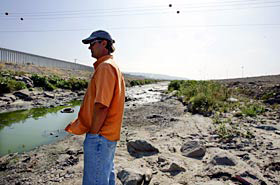 |
 |
 |
 Editorials | Environmental | June 2005 Editorials | Environmental | June 2005  
Tainted Waters
 Janine Zúñiga - Union-Tribune Janine Zúñiga - Union-Tribune


| | Serge Dedina, executive director of local conservation team Wildcoast, at the Tijuana River, says the sewage in the river is the worst he's ever seen. (Photo: K.C. Alfred / Union-Tribune) |
Green stagnant water sits in the concrete Tijuana River channel near the San Ysidro border crossing. Bubbling water thick with sediment passes from Mexico, through Smuggler's Gulch into a U.S. sewage diverter, which sometimes works and at other times is clogged with debris.

Birds drink the dark, smelly water under the Hollister Street bridge as it slowly flows toward the Pacific Ocean.

The river dumps into the ocean south of Imperial Beach, an area some say is a "toxic soup" of contaminants that continues to endanger swimmers and surfers in Imperial Beach and Coronado.

The area, from South Seacoast Drive to the border, was closed 195 out of 212 days between Oct. 1 and April 30, according to county officials. Figures for this month were not readily available.

"We don't even know what's in this water," said Serge Dedina, executive director of local conservation team Wildcoast, as he stood in the Tijuana River channel Wednesday. "We don't know the long-term effects of this water on the people who surf and swim in it."

Dedina said the contamination is caused by street runoff and sewage flowing out of the Tijuana River. He said it is a huge problem, especially for surfers who favor the area, and he plans to do something about it.

"We are requesting funds from a few foundations to prepare a comprehensive border water-quality community action plan so that we find solutions to cleaning up all the sources of pollution, no matter how big and small," Dedina said.

Heal the Bay, a nonprofit group that issued its annual water-quality Beach Report Card this week, identified the stretch south of Imperial Beach as the most polluted beach in California. It tied with Doheny State Beach as the worst beach in the state.

Imperial Beach city officials said they are disappointed that the report card was not more clear. The southernmost beach is not where 95 percent of the city's recreational water activity takes place, they said. The city's main beach is clean and will be open this Memorial Day weekend.

According to county figures, Imperial Beach shores, from Carnation Avenue south to the end of Seacoast Drive, were closed for 106 days from Oct. 1 to April 30. That stretch of beach is on city property. It connects to state and federal beaches as it extends south to the border.

"There is a level of frustration and understanding of what is happening," said City Councilwoman Mayda Winter. "It's absolutely the wet weather." This rain season is the third wettest on record since 1850.

Winter said this is the first time that the beaches south of Seacoast Drive to the border have made the top 10 list of polluted beaches while Doheny has made the list every year. She believes the Imperial Beach area beaches made the list because of heavy rains and urban runoff. Winter said all cities deal with runoff. The difference is that the border area's urban runoff comes from a different country.

Dedina said heavy rains from October through February brought millions of gallons of untreated sewage and urban runoff from Mexico across the border.

Dedina said although it hasn't rained recently, "renegade sewage flows" continue to enter the Pacific Ocean. He blames the U.S. International Boundary and Water Commission, the agency in charge of upgrading sewage treatment at the border.

IBWC spokeswoman Sally Spener said the existing U.S. treatment plant is designed to handle dry-weather flows. A diversion structure in Mexico usually can handle what comes down the Tijuana River channel if there is no rain.

"When there is wet weather, the volume in the Tijuana River exceeds the capacity of the diversion structure to handle it," Spener said. "To state that we're not diverting the flows is not accurate."

Spener said Mexico's diverter has been working since May 9. Prior to that, heavy sewage flows and trash clogged the intake pipe, causing operational problems, she said.

Spener said once a secondary treatment facility in Mexico is completed, sometime around 2008, much more sewage will be treated in Tijuana. The same project also will improve sewage treatment at the South Bay plant, she said.

The project will include infrastructure improvements at the collection site in Tijuana. Spener said the amount of sewage treated will go from the current 25 million gallons a day to 59 million gallons a day.

"Help is on the way," Spener said. "Obviously, the more sewage being treated in Tijuana, the less will get into the (ocean) water."

Results from the county's four southernmost testing stations, those from the south end of Seacoast Drive to the border, have closed that entire stretch of south beaches since Dec. 28. Yesterday, three of the stations tested clean and the surrounding beaches were reopened. The area at the river mouth remained closed due to sewage-contaminated runoff.

Dedina said the area south of Seacoast Drive is one of the best local surfing spots. He said his comprehensive border water-quality action plan will involve people on both sides of the border, who will help outline all sources of pollution and make recommendations for cleaning it up.

"We hope to invite the stakeholders, the leaders in Tijuana and Imperial Beach, the Surfrider Foundation and make it a real community focus," Dedina said.

He said the group may also look at improving the infrastructure in Mexico, building small treatment plants all over Tijuana and perhaps getting rid of the concrete channel in the Tijuana River and replacing it with a greenbelt with parks.

"The people most affected are children, both in Mexico and here," Dedina said. "Kids are swimming in sewage." | 
 | |
 |



